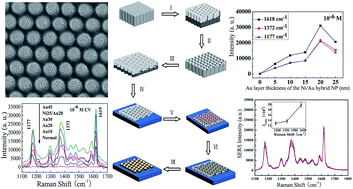Ni/Au hybrid nanoparticle arrays as a highly efficient, cost-effective and stable SERS substrate†
Abstract
A large-area cost-effective Ni/Au hybrid nanoparticle array is synthesized with a proposed versatile and simple process by depositing Au on the pre-prepared arrays of Ni particles with ultra-thin alumina membranes as shadow mask during the deposition. A highly efficient and stable surface enhancement Raman scattering (SERS) substrate could be obtained from utilizing the resulting regular pattern of Ni/Au NP arrays. As compared with the single Au NP arrays, a largely decreased Au evaporation thickness and much lesser Au is needed for achieving the same Raman enhancement factor for the Ni/Au NP arrays. Subsequent SERS spectra measurement of the crystal violet (CV) molecule detection indicate a good SERS-active sensitivity with a detection limit of 10−10 M concentration, a large Raman enhancement factor at 108 was obtained, excellent SERS signal reproducibility with a relative standard deviation (RSD) as low as 6–7% as well as a great long term stability at 10 months.

- This article is part of the themed collection: Surface enhanced Raman Spectroscopy: Editors collection for RSC Advances


 Please wait while we load your content...
Please wait while we load your content...